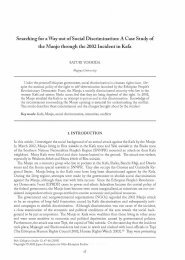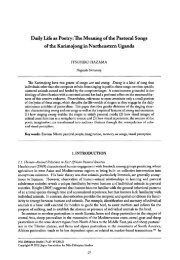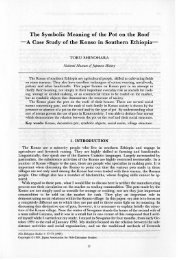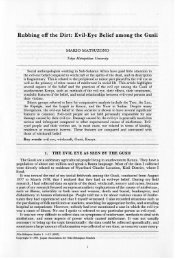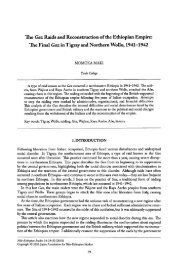Northern Ethiopian Historiography during the Second Half of the ...
Northern Ethiopian Historiography during the Second Half of the ...
Northern Ethiopian Historiography during the Second Half of the ...
Create successful ePaper yourself
Turn your PDF publications into a flip-book with our unique Google optimized e-Paper software.
6 Nilo-<strong>Ethiopian</strong> Studies<br />
have emphasized <strong>the</strong> work <strong>of</strong> Makin. According to M. Kropp, its chronology played an important<br />
role in nor<strong>the</strong>rn <strong>Ethiopian</strong> historiography (Kropp 1989: 211).< 12 ><br />
According to <strong>the</strong> catalogue <strong>of</strong> Ga'az and Amharic manuscripts in <strong>the</strong> British Museum compiled<br />
by W. Wright, Or. 814 is a Ga'az version <strong>of</strong> <strong>the</strong> work by Makin and consists <strong>of</strong> 188 folios. The<br />
author described <strong>the</strong> history from Adam to Tiberius, <strong>the</strong> Roman Emperor (r. 1437) from <strong>the</strong> first<br />
folio to fol. 80r, and he described <strong>the</strong> history <strong>of</strong> <strong>the</strong> Christian world up to <strong>the</strong> reign <strong>of</strong> Heraclius,<br />
<strong>the</strong> Byzantine Emperor (r. 610-641), from fol. 82r to fol. 124r. Mter discussing <strong>the</strong> history <strong>of</strong> <strong>the</strong><br />
Patriarchs <strong>of</strong> Alexandria and <strong>the</strong> ecumenical councils, <strong>the</strong> author started his description <strong>of</strong> <strong>the</strong> history<br />
<strong>of</strong> <strong>the</strong> Islamic world in fol. 154r. and ended this narrative in fol. 188r with his account <strong>of</strong> Baybars II<br />
(Wright 1877: 293-294).< 13 > We have scant information on <strong>the</strong> work <strong>of</strong>Giyorgis Walda Amid, which<br />
Bal;lray consulted. Judging from <strong>the</strong> passage on "<strong>the</strong> history <strong>of</strong> <strong>the</strong> foolish kings <strong>of</strong> Agam or Mridon<br />
and o<strong>the</strong>r Persian kings and those whom we call S<strong>of</strong>i, "0 4 > it is clear that this work included histories<br />
<strong>of</strong> Persian kings.<br />
Although Bal;lray was presumably criticized for writing The History <strong>of</strong> <strong>the</strong> Galla, with questions<br />
such as "Why has he written a history <strong>of</strong> bad people as a history <strong>of</strong> good people?", it is obvious that<br />
<strong>the</strong> readers <strong>of</strong> The History <strong>of</strong> <strong>the</strong> Galla were clergymen and followers <strong>of</strong> <strong>the</strong> <strong>Ethiopian</strong> Church, and<br />
that "good people" referred to <strong>the</strong> saints <strong>of</strong> <strong>the</strong> <strong>Ethiopian</strong> Church. Bal;lray feared such criticism,<br />
although The History <strong>of</strong> <strong>the</strong> Galla was not intended to praise <strong>the</strong> Oromo. It was merely unlike <strong>the</strong><br />
hagiographies written to praise saints. That he refuted criticism by noting that Giyorgis Walda Amid<br />
and o<strong>the</strong>r historians wrote <strong>the</strong> history <strong>of</strong> Muslims, who were "enemies <strong>of</strong> <strong>the</strong> Christians," reveals that<br />
Bal;rray thought that it was <strong>the</strong> Oromo who deserved criticism for causing damage to <strong>the</strong> Christians<br />
in nor<strong>the</strong>rn Ethiopia. Thus, <strong>the</strong> first passages <strong>of</strong> The History <strong>of</strong> <strong>the</strong> Galla show that <strong>the</strong> Christian intellectuals<br />
in nor<strong>the</strong>rn Ethiopia acknowledged that historical works should address good Christians, but<br />
that criticism for describing Oromo history at <strong>the</strong> end <strong>of</strong> <strong>the</strong> 16th century, when <strong>the</strong> kingdom was on<br />
<strong>the</strong> verge <strong>of</strong> ruin by this group, was not warranted. These passages also show that Bal;lray defended<br />
his writing <strong>of</strong> The History <strong>of</strong> <strong>the</strong> Galla by invoking historical works written by Coptic historians in<br />
Egypt.<br />
2. THE PURPOSE OF WRITING THE ROYAL CHRONICLES<br />
2.1. The Purpose <strong>of</strong> Writing <strong>the</strong> Chronicle <strong>of</strong>Siir#i Danga/<br />
At <strong>the</strong> end <strong>of</strong> Chapter 7, <strong>the</strong> author <strong>of</strong> The Chronicle <strong>of</strong>Siir~ii Dangal, which was contemporaneous<br />
with The History <strong>of</strong> <strong>the</strong> Galla, referred to a work called The History <strong>of</strong> <strong>the</strong> Times (Tarika azmanat), edited<br />
by Giyorgis Walda I:Himid. The author criticized this work and included it in his purpose for writing<br />
<strong>the</strong> chronicle (Conti Rossini 1961-1962 I: 80-81).<br />
This purpose was to make readers and listeners praise God and to record "<strong>the</strong> miracles that God<br />
showed in <strong>the</strong> hands <strong>of</strong> this Christian king." Because it was impossible for one author to record all<br />
<strong>the</strong> miracles attributable to God, he did not include <strong>the</strong> entire history from Adam to "<strong>the</strong> medieval<br />
kingdoms <strong>of</strong> <strong>the</strong> Muslims," as did Giyorgis Walda I;Himid. Because he felt that he could not fully<br />
describe all miracles due to <strong>the</strong>ir great number, he said "Let's keep silence; o<strong>the</strong>rwise, I cannot complete<br />
writing <strong>of</strong> <strong>the</strong> greatness <strong>of</strong> God who has done good things."<br />
Chernetsov noted that <strong>the</strong> authors <strong>of</strong> <strong>the</strong> chronicles <strong>of</strong> medieval Ethiopia< 15 > focused "not so much<br />
on human action as on divine acts revealed to <strong>the</strong> world indirecdy 'as deeds <strong>of</strong> <strong>the</strong> Christian king'"<br />
(Chernetsov 1988: 193). The author <strong>of</strong> The Chronicle <strong>of</strong>Siir~ii Dangal intended to encourage readers<br />
to praise God, and he attached importance to <strong>the</strong> miracles caused by God and manifested in <strong>the</strong><br />
deeds <strong>of</strong> Sar$a Dangal, a Christian monarch.<br />
The author <strong>of</strong> The Chronicle <strong>of</strong>Siir~ii Dan gal criticized <strong>the</strong> work <strong>of</strong> Giyorgis Walda ijamid because<br />
<strong>the</strong> latter described world history from <strong>the</strong> creation to "<strong>the</strong> medieval kingdoms <strong>of</strong> <strong>the</strong> Muslims."<br />
According to <strong>the</strong> author <strong>of</strong> The Chronicle <strong>of</strong> Siir$ii Dangal, <strong>the</strong> Muslims oppressed "<strong>the</strong> Christians'<br />
true faith that will bring eternal salvation" and were going to <strong>the</strong> hell as enemies <strong>of</strong> Christianity.




